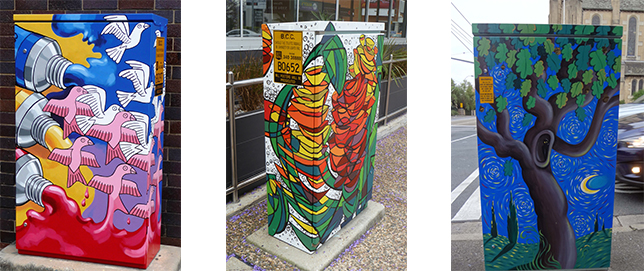Urban Smart Projects: Best Practice in Public Artwork Projects

Urban Smart Projects (USP) is a street art initiative that engages local artists and residents to turn cities into brighter places by painting original artwork onto traffic signal boxes around Australia. USP approaches local councils to commission the project in their local area. Once commissioned, USP places a call out to the local community and artists who are interested in contributing submit an original design to USP for approval. The artists are asked to sign a contract with USP which explains the obligations of both of the parties, including the copyright licensing arrangements. Once the contract is signed, USP provides the artist with the equipment to create their original artwork on a particular signal box in their local area.
Wanting to make sure that the terms of its artist’s contract were respectful of the artist’s rights in their original creations, USP approached Arts Law to review the contract for best practice. The contract confirmed that the artists retained copyright in the works they created. However, USP explained that the councils involved usually wanted to be able to take photos of the artworks for promotional purposes and USP also wanted to be able to put photos of the artworks on its website. Due to the nature of the initiative, the artworks were also not expected to last forever on the signal boxes and would eventually need to be removed. USP asked how to deal with these issues in its contract in a way that was fair to the artists but met the needs of USP and the local councils involved as well.
Arts Law worked closely with USP on the contract ensuring that the copyright licence each artist gave to USP to reproduce their artwork struck the right balance and, importantly, gave USP the right to sub-licence certain rights to the councils as well. Arts Law also advised USP how to deal with the artist’s moral rights of attribution and integrity. The revised contract makes it clear that USP must attribute the artists when reproducing their work wherever practicable and that the artists understand that the nature of the signal box ‘canvas’ means that the artworks may have a limited lifespan. USP were very happy with the outcome.
Having its artist’s contract reviewed for best practice demonstrates USP’s commitment to the artists it is working with and also provides an example to other arts organisations that best practice approaches are not incompatible with commercial considerations.
Further resources
Arts Law’s resources
- Copyright
- Moral Rights
- Contracts (an introduction)
- Contracts a glossary of jargon
- Public Art guidelines for Artists and Commissioners
- Public Art: Design and Commission agreement.
Arts Hub article ‘How to get a Public Art Commission’